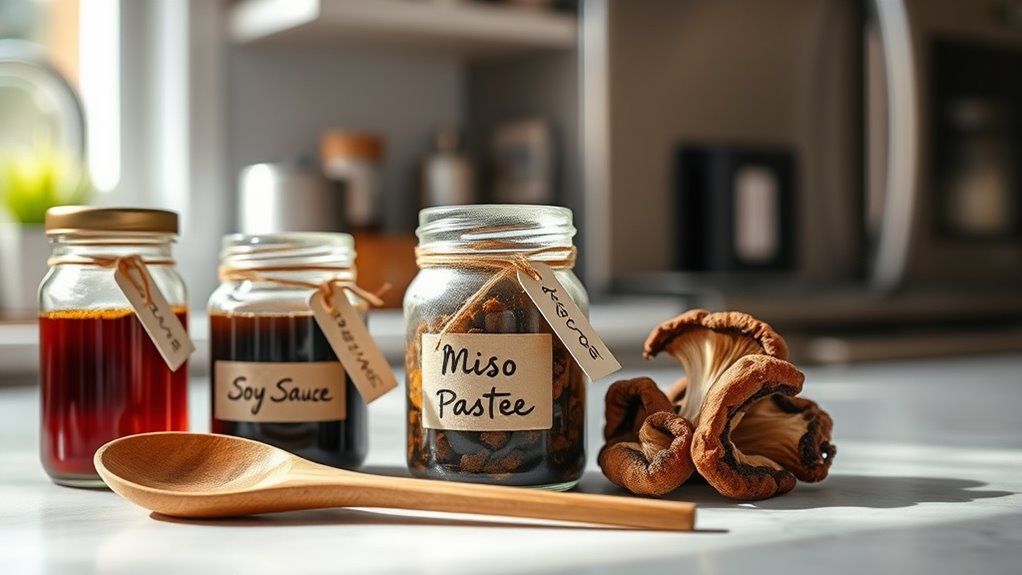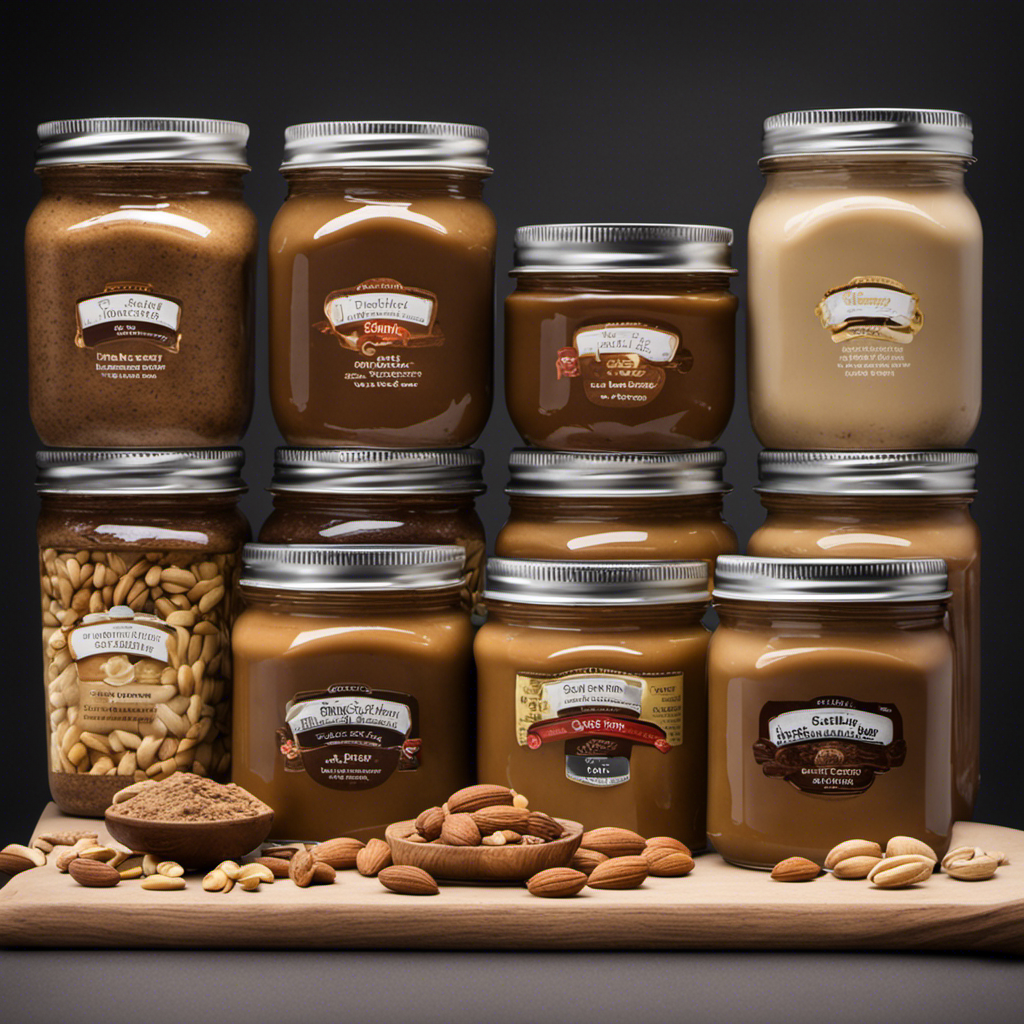You should handle umami boosters like soy sauce, fish sauce, or aged cheeses about once or twice a week to keep flavors balanced. Use small amounts and taste as you go to avoid overpowering dishes. Incorporate them during cooking or at the end for the best results. To master their use and guarantee your dishes stay harmonious, keep exploring tips and strategies that help you get it just right.
Key Takeaways
- Use umami boosters 1-2 times per week to maintain flavor balance and prevent overpowering dishes.
- Incorporate small amounts during initial cooking, tasting frequently to control intensity.
- Limit strong umami sources to special occasions or recipes requiring deeper savory depth.
- Regularly evaluate flavor after leftovers or reheating, adjusting seasonings as needed.
- Rotate different umami ingredients monthly to diversify flavors and avoid overuse.
Understanding Umami Boosters and Their Role in Cooking
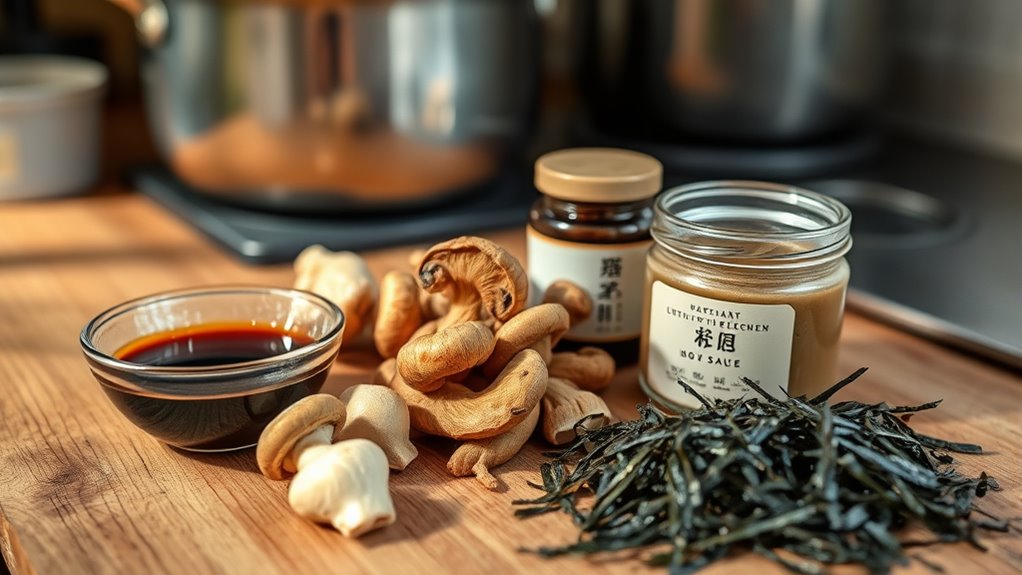
Umami boosters are ingredients that enhance the savory depth of dishes, making flavors more complex and satisfying. These ingredients work through ingredient synergy, amplifying each other’s natural flavors to create a richer taste profile. When used correctly, umami boosters don’t just add saltiness; they elevate the overall flavor, giving dishes a more rounded and savory quality. Common examples include soy sauce, fish sauce, mushrooms, and aged cheeses. Their role isn’t just about taste—it’s about balancing and enhancing other ingredients, ensuring every component complements each other. Understanding how umami boosters function helps you craft more flavorful dishes with less reliance on salt or artificial flavorings. Proper use can transform simple ingredients into deeply satisfying, umami-rich creations.
Signs You’re Using Too Much Umami in Your Dishes
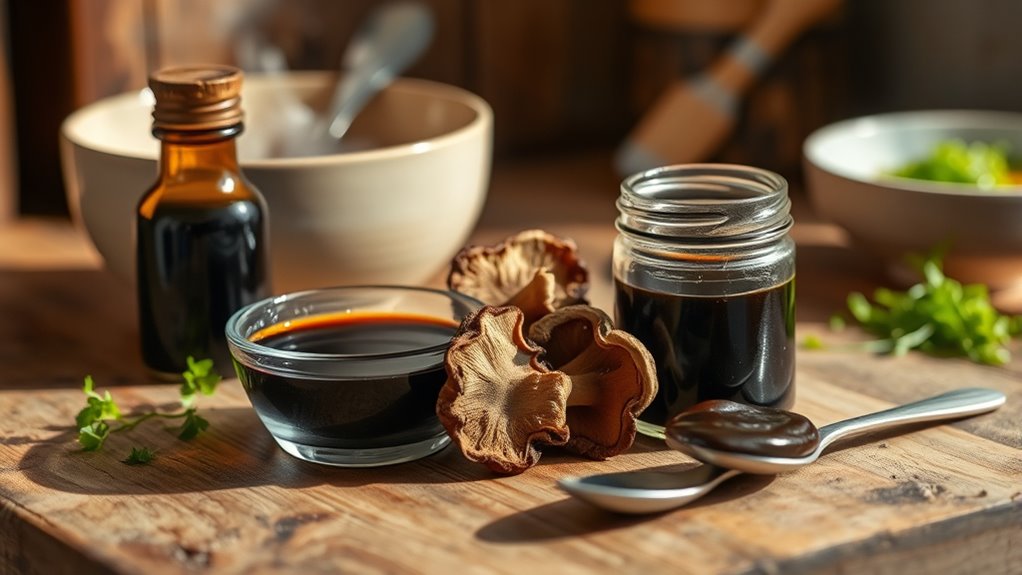
If your dish tastes overwhelmingly savory or the flavors feel unbalanced, you might be using too much umami. When umami dominates, it can overpower other ingredients and mask their natural qualities. Recognizing these signs helps you adjust your seasoning before your dish becomes unappetizing. Using too much umami-rich seasoning can also lead to an unappealing flavor imbalance, reducing the overall enjoyment of your meal.
Overpowering Flavors Dominance
When you add too much umami to your dishes, the flavors can quickly become overpowering, masking other ingredients and disrupting the seasoning balance. An exaggerated umami flavor can dominate the dish, making it feel heavy and unbalanced. If your dish feels overly savory or if certain ingredients lose their distinctiveness, it’s a sign you’ve tipped the scales. Overuse of umami boosters can dull the overall flavor profile, leaving nothing to stand out. You might notice a persistent salty or meaty taste that overshadows the natural flavors. To avoid overpowering flavors, always adjust your umami levels gradually and taste frequently. Maintaining a proper seasoning balance ensures that umami enhances rather than overwhelms, creating a harmonious and well-rounded dish. Being mindful of flavor balance is essential to prevent overpowering your dishes with excess umami.
Unbalanced Dish Taste
A dish that tastes unbalanced often signals you’ve used too much umami. Overdoing it can overpower other flavors and disrupt the overall harmony. To fix this, consider umami substitution options that restore balance. Here are some signs you’re overusing umami:
- The dish tastes overly salty or savory without other flavor layers.
- The depth of flavor masks the dish’s natural ingredients.
- You notice a lingering aftertaste that feels intense or metallic.
- Balancing flavors is key to achieving a well-rounded dish, especially when excess umami has thrown off the harmony.
When this happens, step back and focus on flavor balancing. Try adding acidity (like lemon juice), sweetness (honey or sugar), or fresh herbs to counteract the excess umami. These adjustments help create a more harmonious, well-rounded dish.
Daily Use: When and How to Incorporate Umami Enhancers
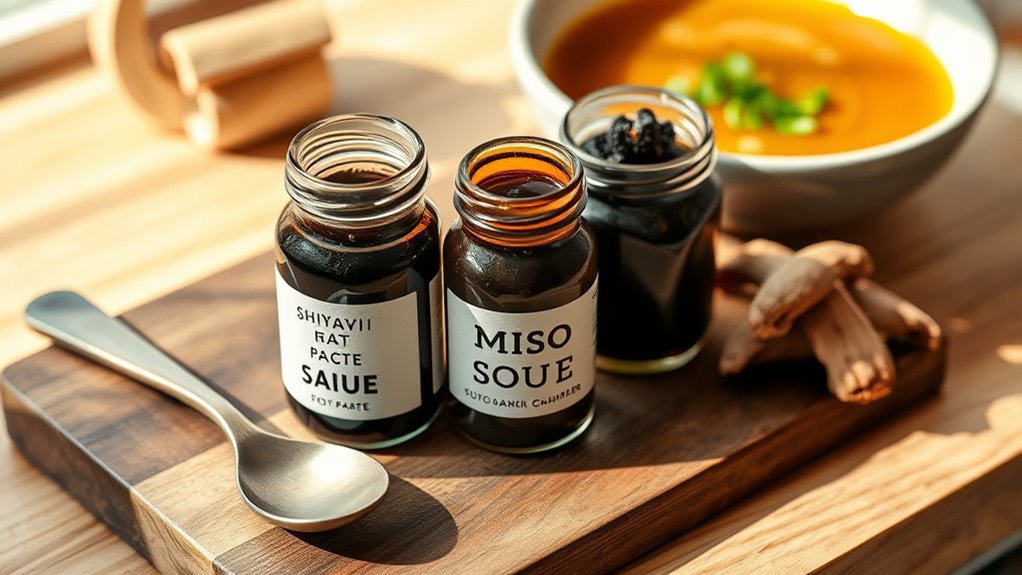
To incorporate umami enhancers daily, timing and portion control are key. Use them during cooking to deepen flavors without overpowering your dish, and keep portions moderate to avoid excess. By mastering these strategies, you’ll enjoy richer meals without overdoing it. Additionally, understanding best anime movies can inspire creative culinary presentations that appeal to a diverse range of tastes.
Optimal Timing Strategies
Incorporating umami boosters into your daily cooking can substantially enhance flavor, but timing matters to maximize their effectiveness. To achieve ideal seasoning balance and flavor harmony, consider these strategies:
- Add umami enhancers during the initial cooking stage to develop depth and integrate flavors thoroughly.
- Use small amounts throughout the process, tasting frequently to maintain control over seasoning balance.
- Finish dishes with a touch of umami just before serving to brighten and elevate overall flavor without overwhelming other ingredients.
- Be aware of potential security vulnerabilities in new flavor-enhancement technologies to prevent unwanted disruptions.
Portion Control Tips
Timing your use of umami boosters is key to achieving the best flavor without overpowering your dish. To do this, focus on portion control and proper ingredient sourcing. Start with small amounts to enhance natural flavors through effective flavor pairing. Taste as you go and adjust gradually, ensuring the umami complements rather than dominates. When sourcing ingredients like soy sauce, miso, or dried mushrooms, choose high-quality options to maximize flavor impact with minimal quantity. Remember, a little goes a long way, so avoid overdoing it. Keep in mind that different dishes require different levels of umami, so consider the overall balance. Using ingredient quality can significantly influence the effectiveness of your umami boosting efforts. By controlling portions and selecting quality ingredients, you’ll elevate your cooking while maintaining harmony in every bite.
Weekly Incorporation: Balancing Flavor Without Overdoing It

Balancing umami boosters throughout the week requires mindful use to enhance flavors without overpowering dishes. To maintain proper flavor intensity, consider these strategies:
- Limit umami seasoning to 1-2 times per week, ensuring it complements rather than dominates.
- Use smaller quantities initially, then adjust based on taste, preventing excessive flavor buildup.
- Rotate different umami sources, like soy sauce, miso, or anchovies, to diversify flavor without overdoing it.
- Incorporating best beaches into your culinary routine can inspire fresh and vibrant flavor pairings that complement umami-rich ingredients.
Monthly Check-In: Adjusting Your Umami Usage Based on Outcomes

Regularly reviewing your umami usage allows you to fine-tune flavor enhancement and prevent over-seasoning. During your monthly check-in, assess how well your dishes balance savory depth with other flavors. Consider whether the ingredient timing was ideal—did you add umami boosters too early or too late? Adjust your approach based on outcomes; if a dish tastes too salty or overpowering, scale back or modify when you incorporate umami ingredients. Track your results to identify patterns, such as which foods benefit from more or less umami. This process helps you develop a nuanced understanding of flavor balancing, ensuring your cooking evolves with experience. Embracing creative practice through regular evaluation and adaptation will deepen your culinary intuition. By making these monthly adjustments, you refine your technique and consistently achieve harmonious, well-rounded dishes.
Special Occasion Cooking: When to Use Stronger Umami Flavors
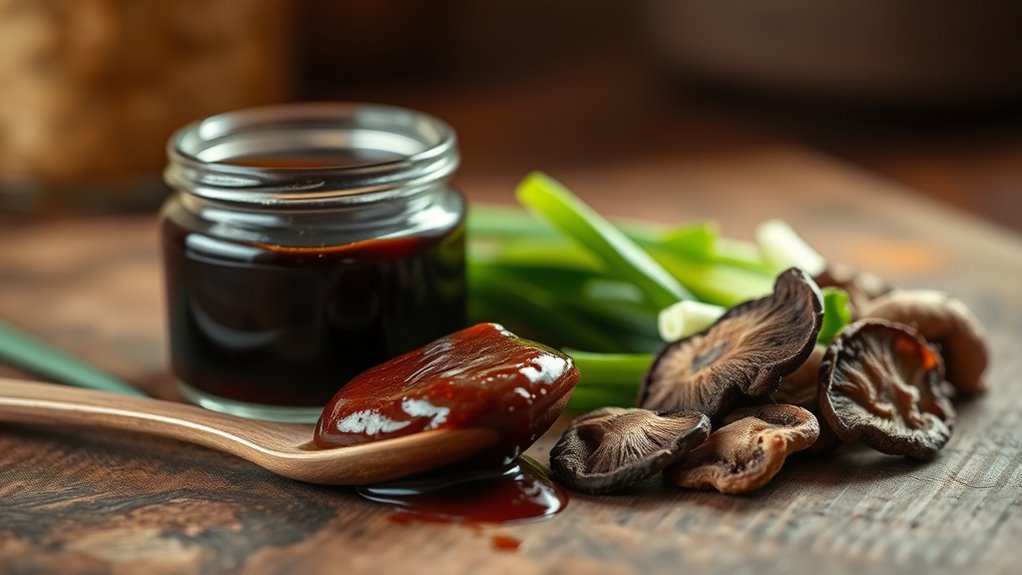
When you’re preparing dishes for special occasions, it’s the perfect time to elevate flavors with stronger umami boosters. These moments call for bold umami flavor profiles that make your dishes stand out. To do this effectively, consider these steps:
- Select robust umami ingredients, like aged cheeses or cured meats, based on your desired flavor intensity and sourcing quality.
- Use umami ingredient sourcing strategies that guarantee freshness and authenticity, such as specialty markets or trusted suppliers.
- Balance the stronger umami flavors with complementary ingredients to prevent overpowering the dish, maintaining harmony and depth.
Handling Leftovers: Maintaining Umami Balance Over Time
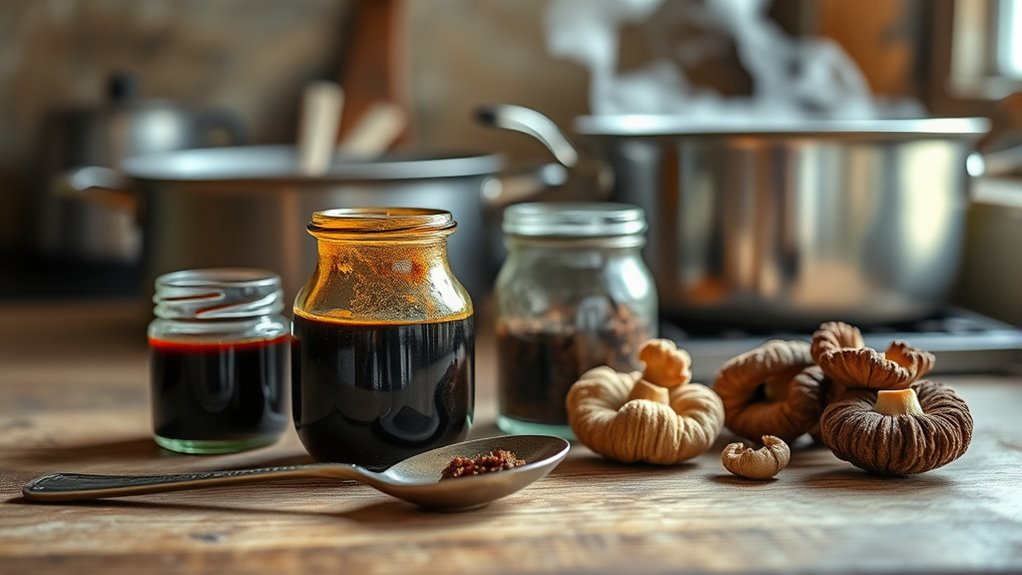
After elevating flavors with strong umami boosters for special occasions, it’s important to contemplate how these bold tastes hold up over time. Proper leftovers preservation is key to maintaining flavor stability. To do this, store leftovers in airtight containers and keep them refrigerated promptly. Reheat gently to avoid breaking down delicate umami compounds. Be mindful that flavor intensity can diminish or shift with time, so tasting before serving helps you adjust seasoning if needed. Use the table below as a quick reference for shelf life and flavor considerations:
| Food Item | Storage Duration | Flavor Stability Tips |
|---|---|---|
| Broth or Soup | 3-4 days | Reheat slowly, add fresh umami if needed |
| Cooked Meat | 3-4 days | Cover tightly, avoid overcooking during reheating |
| Fermented Sauces | Up to 2 weeks | Keep sealed, avoid contamination |
| Marinated Vegetables | 2-3 days | Keep in airtight container, consume quickly |
| Dried Umami Additions | Up to 6 months | Store in a cool, dark place |
Consistently managing leftovers ensures your umami flavors stay balanced and delicious over time. Additionally, understanding food storage techniques can help prevent flavor loss and spoilage.
Personal Taste and Dietary Considerations in Umami Handling

Personal taste and dietary needs play a crucial role in how you handle umami boosters. Your preferences influence the seasoning balance and flavor harmony you aim for in dishes. Consider these factors:
- Dietary restrictions or allergies may limit certain umami sources like soy or MSG, requiring alternative flavor enhancers.
- Personal taste dictates whether you prefer a subtle umami touch or a pronounced boost, affecting how often you add or adjust boosters.
- Cultural or health considerations might influence your approach, balancing umami enhancement with nutritional goals.
- Being aware of recommended formulations can help you select safe and effective umami sources tailored to your needs.
Tips for Experimenting With Umami Frequency Safely
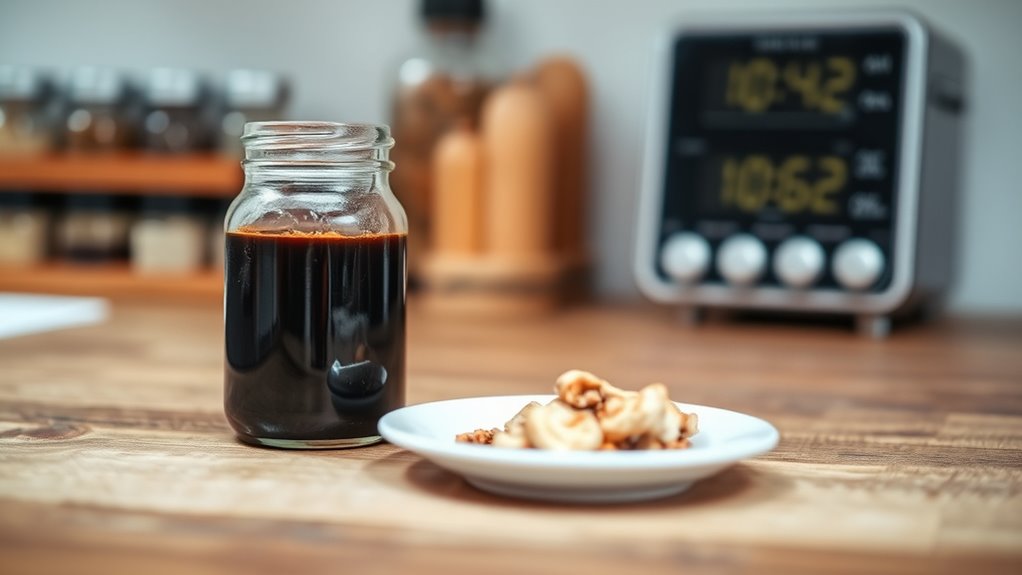
Experimenting with umami frequency can enhance your dishes, but it’s important to do so safely to avoid overpowering flavors or negative health effects. Start by using small amounts of umami-rich ingredients, like soy sauce, miso, or aged cheeses, to gauge their impact. Focus on flavor balancing by tasting as you go, ensuring the umami complements rather than dominates. Keep track of how often you add these boosters to maintain control over the overall taste. Remember, moderation is key—frequent additions can dull your palate or cause unwanted health issues. Gradually increase usage only after you’re comfortable with the flavors. By practicing mindful experimentation, you’ll develop a nuanced approach that elevates your dishes without overwhelming them.
Frequently Asked Questions
Can Excessive Umami Intake Cause Health Issues?
Excessive umami intake can lead to health issues mainly due to high sodium intake, which is common with flavor enhancement. Too much sodium can cause high blood pressure and increase heart disease risk. To stay safe, enjoy umami-rich foods in moderation, balancing them with low-sodium options. Monitoring your sodium intake helps prevent health problems while still enjoying the savory taste benefits of umami.
How Does Umami Affect Dietary Restrictions or Allergies?
Umami can be a double-edged sword if you have dietary restrictions or allergies. If you’re gluten-sensitive or allergic to soy, you need to navigate umami-rich ingredients carefully—think of them as hidden mines in your meal. Some umami boosters, like soy-based products or gluten-containing additives, might trigger reactions. Always check labels and opt for allergy-friendly options to keep your diet safe and flavorful.
Are There Specific Cuisines That Require More Frequent Umami Boosting?
Certain cuisines, like Japanese, Korean, and Chinese, often require more frequent umami boosting due to their reliance on ingredients like soy, miso, and fish sauce for flavor enhancement. These ingredients have a limited shelf life, so you should handle umami boosters regularly to maintain freshness and ideal flavor. Incorporating umami-rich components thoughtfully ensures your dishes stay flavorful without overusing or risking spoilage.
How Do Seasonal Ingredients Influence Umami Booster Frequency?
Ever wondered how seasonal ingredients affect your umami boosting? As seasonal flavors change, you’ll want to adjust your umami boosters accordingly. Fresh ingredients typically provide a natural umami kick, meaning you might need to boost less often. Conversely, during seasons with less fresh umami-rich ingredients, you’ll want to handle umami boosters more frequently to enhance flavor. Stay attentive to ingredient freshness, and your dishes will always taste their best.
Can Umami Boosters Be Used Effectively in Vegetarian or Vegan Dishes?
Yes, you can definitely use umami boosters effectively in vegetarian or vegan dishes. Plant-based flavoring like nutritional yeast, miso, and seaweed serve as vegan-friendly enhancers that deepen flavor without animal products. Incorporate these vegan friendly enhancers regularly to boost umami, balancing dishes naturally. You’ll find that these ingredients add richness and complexity, making your plant-based meals more savory and satisfying.
Conclusion
Next time you open that jar of soy sauce or sprinkle a dash of mushroom powder, remember your schedule. Just like catching a fleeting sunset, balancing umami takes patience and attention. By tuning into your taste buds and adjusting seasonally, you’ll find that perfect harmony—no overload, no blandness. When your dish turns out just right, it’s as if all those small, deliberate touches came together naturally, creating a flavor masterpiece you can enjoy every day.
